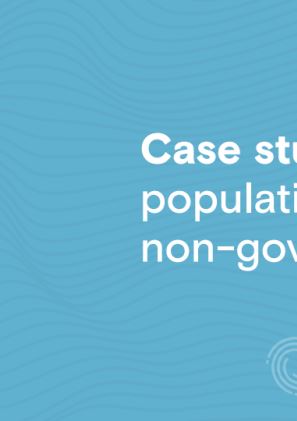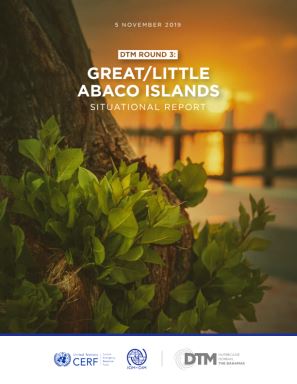-
Countries
-
Data and Analysis
-
Special Focus
-
Crisis Responses
Bahamas
Bahamas
Desplazados internos rastreados
Movimientos de desplazamiento
No hay cifras disponibles
IDMC 2023
Ronda de recopilación de datos
Sobre Bahamas
Between 1-2 September 2019, Hurricane Dorian, a Category 5 storm, devastated The Bahamas. The hardest hit islands were Abaco and Grand Bahama in the north-western section of the country. Over the past few years the country has been affected by at least three major hurricanes, all Category 4 or higher.
The International Organization for Migration (IOM) deployed an Emergency Response Team to the affected areas immediately and is now establishing a country office for the Commonwealth of the Bahamas, based out of Nassau, with a sub-office in Abaco. From the onset of the emergency IOM has been working to conduct internal displacement monitoring on the hosting island of New Providence – with a view of expansion to Grand Bahama and Abaco.
DTM Bahamas aims to collect and disseminate data and information that is complete, accurate, and timely on internal displacement in the regions affected by Hurricane Dorian.
Overall situation of affected areas (hosting IDPs, returnees and population whose houses have been damaged/destroyed) at the lowest geographical level as possible
Demographics and vulnerabilities of the internally displaced populations and returnees
Population movement trends tracking in displacement sites
Sectoral needs, gaps, and service provisions in displacement sites and host communities
Overall, DTM Bahamas seeks to provide:
Data and information at the operational level to facilitate a more targeted approach for planning, prioritization and delivery of assistance and at the strategic level to facilitate evidence-based humanitarian programming
In the mid-term, facilitate evidence-based development of government recovery, reconstruction, and return strategies for New Providence, Grand Bahama, and Abaco, specifically.
Enhanced local capacity on tracking and analysing internal displacement in order to improve information management of population data and identified needs in future discplacement scenarios.
Para obtener resultados de búsqueda más avanzados, vaya a la Página de búsqueda avanzada de informes
The Bahamas — Hurricane Dorian – Round 3 Dashboard (November 2019)
There are 5,705 people residing in in affected settledments. This report covers 23 affected Settlements in the Great/Little Abaco Islands. Outer Cays assessment is on-going.
The Bahamas — Hurricane Dorian – Case Study: Non-Governmental Sites (22–23 September 2019)
This report provides qualitative information on the factors influencing return intentions of affected population staying in collective centers or sites not managed by Government institutions in the Island of New Providence. This case study covers the period 22-23 September 2019.
The Bahamas — Hurricane Dorian – Site Assessment – Round 3 (November 2019)
This multi-sectoral location assessment has been designed with input from the various Emergency Support Functions (ESFs) coordinating the Hurricane Dorian response in the Bahamas.
The Bahamas — Hurricane Dorian – Site Assessment – Round 2 (October 2019)
As part of the Hurricane Dorian emergency response coordinated by NEMA and its partners, the International Organization for Migration (IOM) presents the Site Profiles Report for Children-only Collective Sites Hosting Evacuees on the Island of New Providence, The Bahamas.
The Bahamas — Hurricane Dorian – Site Assessment – Round 1 (September 2019)
The International Organization for Migration (IOM) presents a brief report on the current situation of Government-approved collective sites in New Providence in order to support all humanitarian actors and stakeholders involved in the Dorian Hurricane Emergency Response.
Para obtener resultados de búsqueda más avanzados, vaya a la Página de búsqueda avanzada de conjuntos de datos
Bahamas — Multi-Sectoral Location Assessment — Round 3
2019-11-05
A multi-sectoral location assessment or site assessment is a sub-component of mobility tracking. It aims to collect data on population presence, living conditions and needs in a particular displacement site or community.







